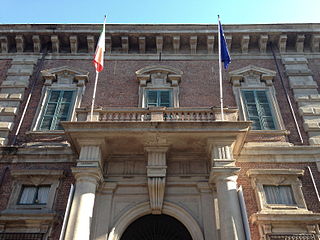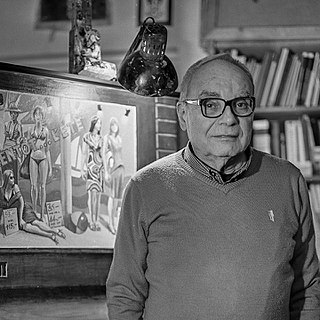
Marino Marini was an Italian sculptor and educator.

Palazzo Brera or Palazzo di Brera is a monumental palace in Milan, in Lombardy in northern Italy. It was a Jesuit college for two hundred years. It now houses several cultural institutions including the Accademia di Brera, the art academy of the city, and its gallery, the Pinacoteca di Brera; the Orto Botanico di Brera, a botanical garden; an observatory, the Osservatorio Astronomico di Brera; the Istituto Lombardo Accademia di Scienze e Lettere, a learned society; and an important library, the Biblioteca di Brera.

Giuseppe Bartolomeo Chiari, also known simply as Giuseppe Chiari, was an Italian painter of the late-Baroque period, active mostly in Rome.

The following is an alphabetical list of articles related to Italy.

Pelagio Palagi was an Italian painter, sculptor and interior decorator.

Francesco Mancini was an Italian painter whose works are known between 1719 and 1756. He was the pupil of Carlo Cignani.

Antonio del Massaro da Viterbo, or Antonio da Viterbo, nicknamed il Pastura was an Italian painter.

The Palazzo Bolognetti-Torlonia, today demolished, was a palace located in Piazza Venezia, Rome, Italy.

Enrico Coleman was an Italian painter of British nationality. He was the son of the English painter Charles Coleman and brother of the less well-known Italian painter Francesco Coleman. He painted, in oils and in watercolours, the landscapes of the Campagna Romana and the Agro Pontino; he was a collector, grower and painter of orchids. Because of his supposedly Oriental air, he was known to his friends as "Il Birmano", the Burmese.
Valentina Moncada di Paternò is an Italian art historian, gallery owner, and curator who specializes in contemporary art. In 1990 she opened an art gallery in Rome in Via Margutta 54, establishing herself as a talent scout due to a program of young international artists who soon became known worldwide.

The Galleria Comunale d'Arte Moderna is the museum of modern and contemporary art of the city of Rome, Italy. It is housed in a former Barefoot Carmelite monastery dating from the 17th century and adjacent to the church of San Giuseppe a Capo le Case, at 24 Via Francesco Crispi.

Sergio Ceccotti is an Italian painter. He lives and works in Rome.

The Polo Museale del Lazio is an office of Italy's Ministry of Cultural Heritage. Its seat is in Rome in the Palazzo Venezia.

Enrico Crispolti was an Italian art critic, curator and art historian. From 1984 to 2005 he was professor of history of contemporary art at the Università degli Studi di Siena, and director of the school of specialisation in art history. He previously taught at the Accademia di Belle Arti in Rome (1966–1973) and at the Università degli Studi di Salerno (1973–1984). He was author of the catalogues raisonnés of the works of Enrico Baj, Lucio Fontana and Renato Guttuso. He died in Rome on 8 December 2018.

Santa Maria in Brera was a church in Milan, in Lombardy in northern Italy. It was built by the Humiliati between 1180 and 1229, given a marble façade and Gothic portal by Giovanni di Balduccio in the fourteenth century, and deconsecrated and partly demolished under Napoleonic rule in the early nineteenth century. The Napoleonic rooms of the Pinacoteca di Brera occupy the upper floor of what was the nave.
Museo Civico may refer to:

The Museo di Roma in Trastevere was established in 1977 in the restored Carmelite convent of Sant'Egidio. It was initially known as the Museo del Folklore e dei Poeti Romaneschi. Following a period of closure it was reopened under its present name in 2000. In addition to a permanent collection related to the recent culture of Rome the museum also houses temporary exhibitions, including the annual World Press Photo exhibition. It is part of the Museo di Roma.
Enzo Carnebianca, is a sculptor and painter born in Rome Italy.

















